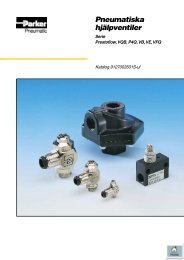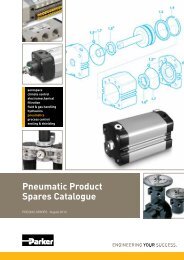Atlas Copco air motors - IAG
Atlas Copco air motors - IAG
Atlas Copco air motors - IAG
Create successful ePaper yourself
Turn your PDF publications into a flip-book with our unique Google optimized e-Paper software.
Choosing your<br />
motor<br />
The working point<br />
When selecting an <strong>air</strong> motor for a certain application, the first step<br />
is to establish what is called the “working point”. This is the point<br />
described by the desired operating speed for the motor and the torque<br />
required at that speed.<br />
The wide operating range of the <strong>air</strong> motor makes it probable that a<br />
number of <strong>motors</strong> could run with the same working point.<br />
However, as it is most efficient to run an <strong>air</strong> motor at the maximum<br />
output speed, the motor that produces maximum power nearest to<br />
the working point should be selected.<br />
The power required at the working point is calculated by:<br />
Power = π x M x n [W]<br />
30<br />
Where, M = Torque at working point (in Nm)<br />
n = Speed at working point (in r/min)<br />
Example:<br />
A non-reversible motor is required to run at 300 r/min and produce a<br />
torque of 10 Nm. Selection of correct motor size is as follows:<br />
Power required (W) = 3.14 x 10 x 300/30 = 314<br />
From Table 5 the correct size of non-reversible<br />
motor for this application is the LZB 33.<br />
Once the motor size has been identified, simply look at the performance<br />
curves for each motor variant and select the one with max<br />
output nearest to the working point. For the above example this<br />
would be the LZB 33 A007.<br />
70 ATLAS COPCO AIRMOTORS<br />
Torque<br />
[Nm]<br />
Desired working point<br />
Torque with standard<br />
motor at 6.3 bar (91 psi)<br />
Torque with throttled<br />
motor<br />
Torque with pressure<br />
regulator<br />
Speed [r/min]<br />
Apply these values to the diagram in figure 31 and read off the<br />
pressure at the intersection point.<br />
LZB 14 LZB 22 LBZ 33/34 LZB 42<br />
Vane <strong>motors</strong><br />
LZB 46 LZB 54 LZL 05 LZL 15 LZL 25 LZL 35<br />
Non reversible A A A A A A<br />
Reversible AR AR AR AR AR AR<br />
Output (kW) 0.10 0.16 0.16 0.25 0.23 0.39 0.50 0.65 0.58 0.84 0.78 1.20 1.3 2.3 3.4 5,2<br />
Table 5<br />
Power<br />
[kW]<br />
0.4<br />
0.3<br />
0.2<br />
0.1<br />
Torque<br />
[Nm]<br />
20<br />
16<br />
12<br />
8<br />
4<br />
200<br />
Air cons.<br />
[l/s]<br />
400<br />
LZB 33 A007<br />
600 800<br />
10<br />
8<br />
6<br />
4<br />
2<br />
Speed<br />
[r/min]<br />
Figure 29<br />
If necessary, one of the flow control methods can be used to modify<br />
the output of a motor to meet the working point exactly<br />
(Figure 30).<br />
Pressure regulation<br />
Sometimes the motor operates at other supply pressures than 6.3<br />
bar. In these cases the performance of a motor must be re-calculated<br />
to ensure the working point can be achieved.<br />
To calculate performance at supply pressures other than 6.3 bar,<br />
multiply the data at 6.3 bar by the correction factors shown in<br />
Table 6.<br />
Air Pressure Output<br />
Correction factors<br />
Speed Torque Air Consumption<br />
(bar) (psi)<br />
7 101 1.13 1.01 1.09 1.11<br />
6 87 0.94 0.99 0.95 0.96<br />
5 73 0.71 0.93 0.79 0.77<br />
4 58 0.51 0.85 0.63 0.61<br />
3 44 0.33 0.73 0.48 0.44<br />
It is also easy to calculate the inlet pressure required to achieve a<br />
desired working point.<br />
Example:<br />
An LZB 22 A036 is required to run at 1155 r/min and produce 1.2 Nm;<br />
calculate the required inlet pressure to achieve this.<br />
For this motor at maximum output the torque is 1.5 Nm and the speed is<br />
1650 r/min.<br />
Therefore M1/M2 = 0.8 and n1/n2 = 0.7<br />
The required inlet pressure is 4.2 bar (61 psi)<br />
M1 = desired torque<br />
n1 = desired speed<br />
M2 = torque at maximum output<br />
n2 = speed at maximum output<br />
Calculate the ratios M1 and n1<br />
M2 and n2<br />
Shows the power output for all <strong>Atlas</strong> <strong>Copco</strong> vane <strong>motors</strong>. The correct motor size is determined by selecting a motor with a power output above that<br />
required at the working point.<br />
Figure 30<br />
Table 6




